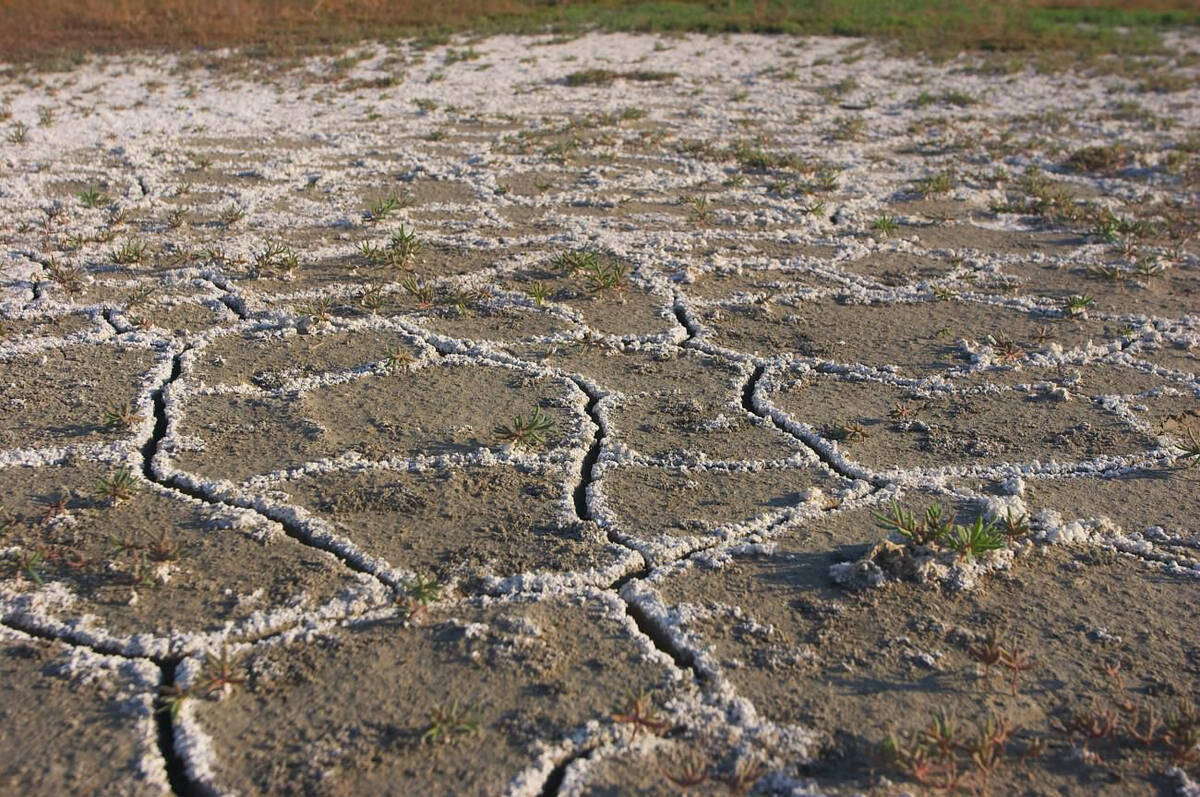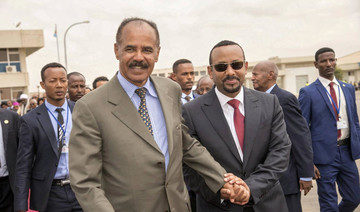ADDIS ABABA: The first commercial flight to Eritrea in two decades departed Wednesday from Addis Ababa after the two nations ended their bitter conflict in a whirlwind peace process.
Ethiopian Airlines said that flight ET0312 to Asmara had departed Bole International Airport, the latest concrete sign of a thaw between the neighboring countries which began only six weeks ago.
“This day marks a unique event in the history of Ethiopia and Eritrea,” the airline’s chief executive Tewolde GebreMariam said at a ceremony inaugurating the historic flight.
Overwhelming demand saw the African aviation giant operate two flights within 15 minutes of each other.
“The fact that we are taking two flights at a time shows the eagerness of the people,” said Tewolde.
An AFP journalist onboard the second flight said champagne was served to passengers in all classes, who toasted each other shortly before take-off.
Smiling flight attendants also handed out roses to the passengers.
Ethiopian Airlines, one of Africa’s fastest-growing carriers, has said it would initially operate a once-a-day return flight between Addis Ababa and Asmara.
“With the demand we are witnessing, I think we’re going to increase the frequency to twice a day, thrice a day and even more,” said Tewolde.
He said the opening of the Eritrean airspace to Ethiopian Airlines would also mean more efficient routes to the Middle East.
Among the passengers on the first flight was former prime minister Hailemariam Desalegn, whose shock resignation in February was the first step in a series of shake ups in Ethiopian politics and the Horn of Africa at large.
“I knew one day it would happen,” Hailemariam said of the peace with Eritrea.
Hailemariam was succeeded in April by Prime Minister Abiy Ahmed, a 42-year-old former army officer and cabinet minister described by analysts as a “man in an extreme hurry.”
After announcing the liberalization of parts of the Ethiopian economy and releasing jailed dissidents, Abiy last month declared his intention to make peace with Eritrea after two decades of frozen relations.
Eritrea was once part of Ethiopia and comprised its entire coastline on the Red Sea until it voted for independence in 1993 after decades of bloody conflict.
A row over the demarcation of the shared border triggered a brutal 1998-2000 conflict which left 80,000 people dead before evolving into a bitter cold war.
Abiy stunned observers with his announcement he would finally accept a 2002 United Nations-backed border demarcation. However he has yet to announce a pull out of troops.
He then paid a historic visit to Eritrea, during which he and President Isaias Afwerki declared an official end to the war. Afwerki reciprocated with a state visit to Ethiopia just days later.
The emotion-filled reunion has been welcomed by Ethiopians, who share strong cultural ties with Eritreans, and many of whom were completely cut off from family during the long years of enmity.
On Monday Afwerki re-opened Eritrea’s embassy in Addis Ababa.
The rapprochement is expected to provide an economic boost to both nations, offering booming Ethiopia — which currently channels its trade through Djiboutian ports — access to Eritrean shores.
Meanwhile Amnesty International has said the newfound peace should be a catalyst for change in Eritrea, one of the world’s most isolated nations.
Since the end of the war, Isaias has used the threat of Ethiopian aggression to justify a rash of repressive policies, including an indefinite national service program the UN has likened to slavery.
First commercial flight in 20 years leaves Ethiopia for Eritrea
First commercial flight in 20 years leaves Ethiopia for Eritrea

- Ethiopian Airlines, one of Africa’s fastest-growing carriers, has said it would initially operate a once-a-day return flight between Addis Ababa and Asmara
- Eritrea was once part of Ethiopia and comprised its entire coastline on the Red Sea until it voted for independence in 1993 after decades of bloody conflict
Mapping Saudi soils to grow better crops

- Palm trees, root crops, and coastal plants reveal the land’s story
RIYADH: Saudi Arabia’s land tells stories written beneath the feet. From fertile plains and rugged highlands to vast deserts, the Kingdom’s diverse landscapes shape what can grow, where it grows, and how agriculture can thrive.
Alongside geography and climate, soil conditions play a decisive role in agricultural success. Understanding soil types across the Kingdom helps determine which crops can flourish and what interventions may be needed to sustain them.
In an interview with Arab News, Turki Almutairi, a senior environmental specialist at the National Afforestation Center under the National Center for Vegetation Cover Development and Combating Desertification, outlined the main soil types found across Saudi Arabia.

“The dominant soil in the Kingdom are sandy desert soils, alongside calcareous soils in the central region. Rocky and stony soils are present along mountainous and hilly landscapes,” he said.
“Alluvial soils are common in wadies (valleys), while saline and sodic soils are located in depressions (Sabkhas) and along coastlines. Pockets of clayed soils can be also found around few sites along the Kingdom.”
The Kingdom’s vast territory gives rise to unique soil characteristics in each region, enabling different crops to grow depending on local conditions.
“Soil is the growing medium for plants. The role of soil includes structural stabilization, providing nutrients and a communication medium for plants,” Basil Nasir, soil lead at engineering consultancy William Sale Partnership, told Arab News.

According to Nasir, assessing soil use is essential before determining whether it is fertile or infertile, as different soils support different plant types.
“The soil used for trees differs from the soil used for ornamental plants and from the soil used for aquatic plants. It varies according to the specific needs of each plant, and based on this, we determine what the soil requires and assess its fertility,” he said.
Nasir explained that soil characteristics are shaped by both physical and chemical components. In addition to water and air, mineral particles such as sand, silt and clay are key indicators of soil health. Organic matter, derived from plant and animal remains, forms the fourth major component.
The balance between these elements determines soil behavior. One important physical trait is water-holding capacity, which influences what types of plants a soil can support.
Opinion
This section contains relevant reference points, placed in (Opinion field)
“If the soil is like dunes, adding water will cause it to run off, but if the soil is clay, its ability to retain water will be very high. If you add water and return the next day, you will find that the water is still there,” said Nasir.
Chemical properties, such as whether soil is alkaline or acidic, are equally important. Understanding both physical and chemical traits allows for proper assessment and treatment when needed.
“What determines whether a plant is suitable for a particular environment is primarily the plant's nature. For example, some plants have fibrous roots and therefore do not require well-draining soil,” Nasir added.
“A palm tree, for example, does not care whether it was planted in one soil or the other because its roots are fibrous. Therefore, palm trees are strong plants and are suitable to grow in both dry and wetlands, while preferring sandy areas.”

Crops such as potatoes, onions, carrots and beetroots — where the edible part grows underground — typically thrive in sandy soils. As a result, plantations of these crops are commonly found in northern regions such as Hail and in Wadi Ad-Dawasir.
In the eastern region, including Al-Ahsa, wetlands are more common due to climatic conditions. Growing plants in such environments often requires human intervention.
“Plants that are coastal or could be found in lagoons or lakes must have some sort of soil around them, like lotus flowers and mangrove trees.”
“An important parameter to keep in mind is that there is no air in its soil, and they are adapted to this condition. However, the lack of air, along with the presence of organic matter, will create a situation where anaerobic bacteria react with the soil, potentially causing diseases we can easily avoid,” said Nasir.
He emphasized that removing organic matter from such soils is essential to ensure plant survival in aquatic environments.
Mountainous and rocky regions in Saudi Arabia are generally volcanic, resulting in low water-holding capacity and challenging growing conditions. However, volcanic ash contributes to high fertility, allowing certain crops to flourish.
As a result, western regions support tree crops such as coffee, mangoes, some banana varieties and pomegranates.

As development accelerates across the Kingdom, soil improvement efforts are expanding under the National Greening Program.
“Soil is considered fundamental for the National Greening Program’s objectives. Understanding the soil variability along the Kingdom is a precondition for fostering sustainable soil management,” Almutairi told Arab News.
Adding, “In this line, the NGP is working towards the establishment of the Saudi Soil Information System (TURBA-KSA), which consists of mapping soils and its functional properties in the Kingdom using state-of-the-art technology.”
He also noted the creation of the “Land Rehabilitation Watch” to report, verify and monitor land rehabilitation nationwide.
“This milestone allows the Kingdom to understand how soil and land health are progressing against national and international targets of land degradation neutrality. Documenting good soil and land management practices is also important, so that those successful practices could be scaled up along the Kingdom, which is a priority task for NGP,” he said.
Raising public awareness is another key pillar of the program.
“Assessing different emerging technologies and soil amendments is a daily activity of NGP, as it then provides technical support to partners on the selection and application of these technologies.”
DID YOU KNOW?
• Saudi Arabia cultivates around 1 million hectares, mainly in Riyadh, Qassim, Hail, and Jouf.
• Farming follows the seasons: winter brings onions, garlic, and carrots, while summer yields watermelon, tomatoes, and cucumbers.
• The Kingdom is a top date producer, with over 31 million palm trees generating nearly 1.54 million tons, especially in Riyadh and Qassim.
Almutairi stressed that soil is often overlooked because it lies unseen beneath the surface, despite its critical role.
Yet soil produces 95 percent of food, stores water, holds more carbon than vegetation and the atmosphere, suppresses contaminants, regulates water, carbon and nutrient cycles, and hosts microorganisms linked to the human microbiome.
He emphasized the need to engage the general public, particularly urban communities disconnected from nature. Education helps people understand where food comes from and how contact with soil — such as walking barefoot — can support well-being. Healthy soils also contribute to cleaner water and air, he added.
Almutairi also called for stronger advocacy among decision-makers, noting that investment in healthy soils supports climate action, food security and sustainable development.
He concluded that key strategies include officially observing UN World Soil Day on Dec. 5, integrating soil education into curricula, launching annual social media campaigns, using art to raise awareness, and organizing public events that connect soils to everyday life.











